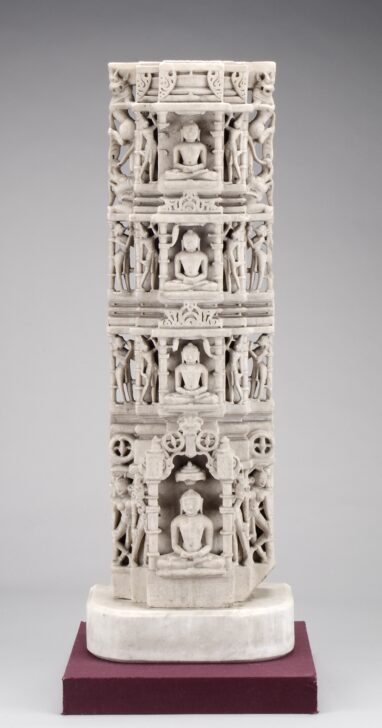Column with Four Jinas and Attendants (Jain Marble Column)
Artist Unknown, India, Rajasthan or Gujarat, Jain

Description
March 28, 2009
The fine white marble and refined, deeply undercut surface of this column suggest that it was made for one of the great Jain temple complexes of southern Rajasthan and northern Gujarat. There, between the tenth and thirteenth centuries, sculptors transformed local marble into grand structures with elaborate, lace-like surfaces, using abrasion rather than the chisel to achieve the detail visible in this fragment. On the front are four parikaras, or image frames, each of which suggests a tiny temple housing a Jina—a Jain teacher—seated in lotus position. By housing figures in this manner on its every structure and surface, the temple becomes a panorama of the Jain pantheon. The figures, which include Jinas, subdivinities, dancers, ascetics, and angels, are arranged so as to symbolize the vault of heaven and the divine assembly.
(Label for UMMA South and Southeast Asia Gallery Opening Rotation, March 2009)
Subject Matter:
The Jaina temples of Gujarat and Rajasthan were often carved out of marble and the carvings are very detailed and elaborate. Images of the jinas, the line of twenty-four teachers, predominate and are multiplied over many of the architectural elements.
Physical Description:
This column fragment consists of a base with a seated jina in the center with a tiered umbrella above him under an elaborate arch flanked by two figures to either side—two male and dancing females at the outside. Three virtually identical bands above it represent smaller seated jinas in less elaborate pavilions. A pair of male cauri bearers with a devotional male on the outside flanks each of the two central figures. The top figure is flanked by the pair of cauri bearers, but with an elephant surmounted by a lion figure on either side. There is no cognizance present to identify any of the four jinas, all are depicted in lotus position and their hands in dhyana mudra, a meditation gesture.
Usage Rights:
If you are interested in using an image for a publication, please visit https://umma.umich.edu/request-image/ for more information and to fill out the online Image Rights and Reproductions Request Form.